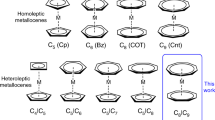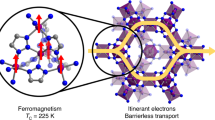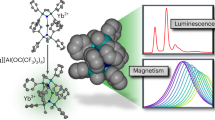Abstract
Single-molecule magnets approach the ultimate size limit for spin-based devices. These complexes can retain spin information over long periods of time at low temperature, suggesting possible applications in high-density information storage, quantum computing and spintronics. Notably, the success of most such applications hinges upon raising the inherent molecular spin-inversion barrier. Although recent advances have shown the viability of lanthanide-containing complexes in generating large barriers, weak or non-existent magnetic exchange coupling allows fast relaxation pathways that mitigate the full potential of these species. Here, we show that the diffuse spin of an N23− radical bridge can lead to exceptionally strong magnetic exchange in dinuclear Ln(III) (Ln = Gd, Dy) complexes. The Gd(III) congener exhibits the strongest magnetic coupling yet observed for that ion, while incorporation of the high-anisotropy Dy(III) ion gives rise to a molecule with a record magnetic blocking temperature of 8.3 K at a sweep rate of 0.08 T s−1.
This is a preview of subscription content, access via your institution
Access options
Subscribe to this journal
Receive 12 print issues and online access
$259.00 per year
only $21.58 per issue
Buy this article
- Purchase on Springer Link
- Instant access to full article PDF
Prices may be subject to local taxes which are calculated during checkout




Similar content being viewed by others
References
Sessoli, R., Gatteschi, D., Caneschi, A. & Novak, M. A. Magnetic bistability in a metal-ion cluster. Nature 365, 141–143 (1993).
Gatteschi, D., Sessoli, R. & Villain, J. Molecular Nanomagnets (Oxford Univ. Press, 2006).
Waldmann, O. A criterion for the anisotropy barrier in single-molecule magnets. Inorg. Chem. 46, 10035–10037 (2007).
Neese, F. & Pantazis, D. A. What is not required to make a single molecule magnet. Faraday Discuss. 148, 229–238 (2011).
Ako, A. M. et al. A ferromagnetically coupled Mn19 aggregate with a record S = 83/2 ground spin state. Angew. Chem. Int. Ed. 45, 4926–4929 (2006).
Bogani, L. & Wernsdorfer, W. Molecular spintronics using single-molecule magnets. Nature Mater. 7, 179–186 (2008).
Stamp, P. C. E. & Gaita-Ariño, A. Spin-based quantum computers made by chemistry: hows and whys. J. Mater. Chem. 19, 1718–1730 (2009).
Mannini, M. et al. Magnetic memory of a single-molecule quantum magnet wired to a gold surface. Nature Mater. 8, 194–197 (2009).
Leuenberger, M. N. & Loss, D. Quantum computing in molecular magnets. Nature 410, 789–793 (2001).
Ardavan, A. et al. Will spin-relaxation times in molecular magnets permit quantum information processing? Phys. Rev. Lett. 98, 057201 (2007).
Ishikawa, N., Sugita, M., Ishikawa, T., Koshihara, S.-y. & Kaizu, Y. Lanthanide double-decker complexes functioning as magnets at the single-molecular level. J. Am. Chem. Soc. 125, 8694–8695 (2003).
Ishikawa, N., Sugita, M., Ishikawa, T., Koshihara, S. & Kaizu, Y. Mononuclear lanthanide complexes with a long magnetization relaxation time at high temperatures: a new category of magnets at the single-molecular level. J. Phys. Chem. B 108, 11265–11271 (2004).
Rinehart, J. D. & Long, J. R. Slow magnetic relaxation in a trigonal prismatic uranium(III) complex. J. Am. Chem. Soc. 131, 12558–12559 (2009).
Freedman, D. E. et al. Slow magnetic relaxation in a high-spin iron(II) complex. J. Am. Chem. Soc. 132, 1224–1225 (2010).
Ishikawa, N., Mizuno, Y., Takamatsu, S., Ishikawa, T. & Koshihara, S.-y. Effects of chemically induced contraction of a coordination polyhedron on the dynamical magnetism of bis(phthalocyaninato)dysprosium, a single-4f-ionic single-molecule magnet with a Kramers ground state. Inorg. Chem. 47, 10217–10219 (2008).
AlDamen, M. A. et al. Mononuclear lanthanide single molecule magnets based on the polyoxometalates [Ln(W5O18)2]9− and [Ln(β2-SiW11O39)2]13− (LnIII = Tb, Dy, Ho, Er, Tm, and Yb). Inorg. Chem. 48, 3467–3479 (2009).
Lin, P.-H. et al. A polynuclear lanthanide single-molecule magnet with a record anisotropic barrier. Angew. Chem. Int. Ed. 48, 9489–9492 (2009).
Guo, Y.-N. et al. Two-step relaxation in a linear tetranuclear dysprosium(III) aggregate showing single-molecule magnet behavior. J. Am. Chem. Soc. 132, 8538–8539 (2010).
Hewitt, I. J. et al. Coupling Dy3 triangles enhances their slow magnetic relaxation. Angew. Chem. Int. Ed. 49, 6352–6356 (2010).
Wernsdorfer, W., Aliaga-Alcalde, N., Hendrickson, D. N. & Christou, G. Exchange-biased quantum tunnelling in a supramolecular dimer of single-molecule magnets. Nature 416, 406–409 (2002).
Evans, W. J. et al. Isolation of dysprosium and yttrium complexes of a three-electron reduction product in the activation of dinitrogen, the (N2)3− radical. J. Am. Chem. Soc. 131, 11195–11202 (2009).
Benelli, C. & Gatteschi, D. Magnetism of lanthanides in molecular materials with transition-metal ions and organic radicals. Chem. Rev. 102, 2369–2388 (2002).
Caneschi, A., Dei, A., Gatteschi, D., Sorace, L. & Vostrikova, K. Antiferromagnetic coupling in a gadolinium(III) semiquinonato complex. Angew. Chem. Int. Ed. 39, 246–248 (2000).
Costes, J-P., Dahan, F. & Dupuis, A. Influence of anionic ligands (X) on the nature and magnetic properties of dinuclear LCuGdX3·nH2O complexes (LH2 standing for tetradentate Schiff base ligands deriving from 2-hydroxy-3-methoxybenzaldehyde and X being Cl, N3C2, and CF3COO). Inorg. Chem. 39, 165–168 (2000).
Yoshihara, D., Karasawa, S. & Koga, N. Cyclic single-molecule magnet in heterospin system. J. Am. Chem. Soc. 130, 10460–10461 (2008).
Milios, C. J. et al. A record anisotropy barrier for a single-molecule magnet. J. Am. Chem. Soc. 129, 2754–2755 (2007).
Lukens, W. W. & Walter, M. D. Quantifying exchange coupling in f-ion pairs using the diamagnetic substitution method. Inorg. Chem. 49, 4458–4465 (2010).
Acknowledgements
The authors thank the National Science Foundation for support (grant no. CHE-0617063 and CHE-1010002) and T. David Harris for valuable discussions.
Author information
Authors and Affiliations
Contributions
W.J.E. and M.F. designed and executed the synthesis and crystallographic characterization of all compounds. J.R.L. and J.D.R. planned and executed the magnetic measurements and analysed the resulting data. All authors were involved in the writing of the manuscript.
Corresponding authors
Ethics declarations
Competing interests
The authors declare no competing financial interests.
Supplementary information
Supplementary information
Supplementary information (PDF 1282 kb)
Supplementary information
Crystallographic data for compound 1 (CIF 24 kb)
Supplementary information
Crystallographic data for compound 2 (CIF 21 kb)
Rights and permissions
About this article
Cite this article
Rinehart, J., Fang, M., Evans, W. et al. Strong exchange and magnetic blocking in N23−-radical-bridged lanthanide complexes. Nature Chem 3, 538–542 (2011). https://doi.org/10.1038/nchem.1063
Received:
Accepted:
Published:
Issue Date:
DOI: https://doi.org/10.1038/nchem.1063
This article is cited by
-
Synthesis, characterization, in vitro antimicrobial activity, DNA binding assay, antioxidant and anti-inflammatory efficacy of trinuclear heterobimetallic complexes of Ni(II) derived by the reaction of [Ni(C13H12N2O)2]Cl2 with dialkyl/diaryl organometallic dichlorides
Research on Chemical Intermediates (2023)
-
Approaching the uniaxiality of magnetic anisotropy in single-molecule magnets
Science China Chemistry (2023)
-
Achieving large thermal hysteresis in an anthracene-based manganese(II) complex via photo-induced electron transfer
Nature Communications (2022)
-
Computational design of magnetic molecules and their environment using quantum chemistry, machine learning and multiscale simulations
Nature Reviews Chemistry (2022)
-
Identification of Seven-coordinate LnIII Ions in a LnIII[15-MCFeIIIN(shi)-5](OAc)2Cl Species Crystallized from Methanol and Pyridine
Journal of Chemical Crystallography (2022)



